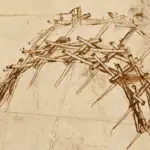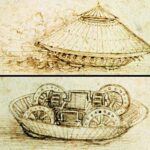Leonardo da Vinci car, a self-propelled cart, showcases the ingenuity of this Renaissance polymath.
He designed this cart to move independently without any need for external force, making it a pioneering idea in the realm of transportation.
While the concept was conceived in the 15th century, the technology was advanced and foreshadowed future automotive developments.
This self-propelled vehicle, known as Leonardo’s self-propelled cart, functions with a complex system of gears and springs that propels it forward.
Despite being created long before engines were invented, the cart is often regarded as the ancestor of modern cars, drawing interest from historians and engineers alike.
Its innovative design showcased da Vinci’s exceptional ability to foresee future technological advancements.
In the early 2000s, a team from The Institute and Museum of the History of Science in Florence attempted to bring Leonardo’s vision to life.
They meticulously recreated the car, using the original designs and materials specified by da Vinci.
This project highlighted the challenges and the brilliance of his original blueprint, inspiring modern inventors and historians to re-examine da Vinci’s contributions to the world of transport.
Leonardo da Vinci: The Inventor
Leonardo da Vinci was a pioneer in both art and science. His curiosity was boundless, leading him to create designs that were remarkably ahead of his time.
Among his many creations, the Leonardo da Vinci self-propelled cart is considered the modern automobile’s ancestor.
Inventions and Engineering
Leonardo was more than just an artist; he was a visionary. His inventions included various machines and designs, many of which remained on paper due to the technological limitations of his time.
One of his significant creations, the self-propelled cart, was powered by springs and could move independently.
This early concept was revolutionary, laying the groundwork for future developments in transportation.
He designed other machines, such as flying and war machines, showcasing his vast understanding of mechanics and anatomy.
These designs demonstrated his ability to combine functionality with structural beauty, making him a prolific inventor whose work influences engineering and design even today.
Historical Context of da Vinci’s Designs
During the Renaissance, a period of significant intellectual and creative growth, da Vinci flourished. This era encouraged exploration in science and the arts, allowing him to pursue diverse interests.
His work as an engineer and inventor gained attention, but the resources to bring his complex designs, like the da Vinci car, to life were limited.
Leonardo’s sketches conveyed ideas for machines such as the helicopter and the tank, far surpassing the technical capabilities of the 15th century.
His designs reflected a deep understanding of physics and mechanics, depicting a world ripe with possibilities if only technology had existed to build such innovations.
Concept of the da Vinci Car
Leonardo da Vinci’s foray into vehicle design introduced ideas that significantly predate the modern automobile. His creations showcased innovative elements that intrigued historians and inventors alike.
Design Characteristics
The Leonardo da Vinci self-propelled cart was a groundbreaking concept that illustrated his forward-thinking approach.
This early vehicle was powered by coiled springs, offering kinetic energy that set it apart from hand-drawn carts.
The design included drum-like casings, where two symmetric springs provided the necessary power.
Leonardo’s self-propelled cart also featured mechanisms for steering and brakes, demonstrating a sophisticated understanding of motion and control.
Once the brake was released, the cart could move autonomously, making it an impressive example of mechanical engineering for its time.
Scholars suggest that da Vinci’s design was aimed at theatrical displays, presenting an engineering marvel during events or performances. His focus on symmetry in power delivery also showcased his quest for balance and efficiency in design.
Technological Interpretation
The technological brilliance of the da Vinci car lies in its interpretation of stored energy and motion.
Although undelivered in his lifetime, the conceptual execution is notable for its mechanical innovation.
Recent analyses and reconstructions, such as one displayed at Italy’s National Automobile Museum, have confirmed the working principles behind the da Vinci self-propelled cart.
His sketches, while incomplete, provided a foundation for modern interpretations of autonomous vehicles.
The mechanical prowess observed in da Vinci’s designs laid the groundwork for future inventors to explore powered movement.
The self-propelled cart Leonardo da Vinci signifies a bridge between ancient transport concepts and modern vehicular technology.
By harnessing spring energy, da Vinci expanded the possibilities of machine autonomy long before the industrial advancements of later centuries.
Mechanisms of the da Vinci Car
The Leonardo da Vinci self-propelled cart showcases ingenious mechanisms that highlight his innovative autonomous motion approach. It features a combination of springs and gears that propel the vehicle forward.
Anatomies of Motion
Leonardo’s self-propelled cart uses a series of coiled springs as the main energy source.
When wound, these springs store potential energy and release it to drive the cart forward.
Essential gears and levers help convert this energy into rotational motion, leading to the movement of wheels.
The cart includes a steering mechanism that allows direction changes.
This makes it a precursor to modern vehicles, demonstrating an early understanding of complex motion control.
The intricacy of the design reflects Leonardo’s visionary ideas long before motorized transport became a reality.
Da Vinci’s Influence on Modern Transportation
Leonardo da Vinci’s inventive mind created concepts that laid the groundwork for various modern transportation systems. His designs show innovative thinking, emphasizing both practicality and forward-thinking engineering principles.
Automotive Innovations
Leonardo’s self-propelled cart, or da Vinci car, is often considered a precursor to the modern automobile.
Designed in the late 15th century, this cart featured complex mechanisms, including springs and gears that allowed it to move without external force.
Though it was never built during his time, this invention highlighted the potential for self-powered vehicles.
His innovative approach included a wind-up mechanism, showcasing his understanding of potential energy and mechanical function.
This design inspired future engineers and inventors, providing a conceptual basis for developing self-moving cars centuries later.
Legacy in Engineering and Design
Leonardo’s detailed sketches and engineering principles demonstrated a deep understanding of mechanics, influencing generations of engineers and designers.
His exploration of motion and force continues to be relevant, contributing to foundational theories in physics and engineering.
The precision and foresight in da Vinci’s designs encourage modern thinkers to blend creativity with technical expertise.
His work paved the way for innovations such as modern aerodynamics and structural engineering practices.
Combining artistic skill and scientific inquiry results in a legacy ending in today’s transportation design, reflecting aesthetic appeal and functional excellence.
Preservation of Leonardo da Vinci Car
The Leonardo da Vinci car, a remarkable feat of engineering, remains a focal point for historical and technological discussions.
Replicas and Models
Creating replicas of the self-propelled cart, Leonardo da Vinci designed has become crucial for understanding his ideas.
Organizations like Aurea Exhibitions collaborate with skilled artisans to craft these models.
This process involves interpreting da Vinci’s detailed sketches and writings, ensuring accuracy in the reproduction.
The replicas are often displayed in educational settings, allowing students and technology enthusiasts to study and engage with historical engineering.
Visitors to the Museum of Boulder can test models that mimic da Vinci’s original ideas, such as flying machines and war weapons, alongside the self-propelled cart.
These educational tools highlight the link between da Vinci’s innovations and today’s technological advancements.
Final Thoughts
Leonardo da Vinci’s exploration of mechanics was extraordinary for his time. His designs, such as the self-propelled cart, reveal his vision of creating machines that could move autonomously. Leonardo’s sketches exhibit remarkable ingenuity.
In designing the cart, Leonardo used springs to store energy, which would then be released to propel the vehicle forward. This concept is considered a precursor to the modern car.
Although the cart was never built in his lifetime, it demonstrates his innovative spirit.
Key Takeaways:
- Leonardo da Vinci envisioned and designed a self-propelled cart that laid the groundwork for future advancements in automobile technology.
- His work remains a testament to his role as a pioneer in engineering and design.
Frequently Asked Questions
Leonardo da Vinci was a visionary with many innovative ideas, including designs for what some consider the earliest version of a car and other remarkable inventions. Below, common questions address these and other related topics.
Who drew the first car in 1478?
Leonardo da Vinci is credited with drawing the early concept of a self-propelled vehicle around 1478. His design included springs and gears to move autonomously. This remarkable blueprint is seen as an ancestor of modern cars.
What was the flaw with Leonardo’s armored car?
Leonardo’s armored car design was innovative but had a significant flaw in its steering mechanism.
This weakness could potentially cause the car to lose control. Despite this, it paved the way for future armored vehicle designs.
How much did Salvator Mundi by Leonardo da Vinci cost?
The painting Salvator Mundi by Leonardo da Vinci sold for a record-breaking $450.3 million at auction in 2017. This made it one of the most expensive paintings ever sold, and it underscored Leonardo’s enduring influence on art.
How wealthy was Leonardo da Vinci when he died?
Leonardo da Vinci died with considerable wealth for his time. His assets included valuable artworks, estates, and personal belongings.
Although exact amounts are hard to quantify, he was financially comfortable when he passed away in 1519.
Did Da Vinci make a car?
Leonardo da Vinci did not construct a working car but designed a self-propelled cart. This design featured complex mechanisms intending to operate independently.
Though never built in his lifetime, it inspired future automotive explorations.
Who invented the oldest car?
The oldest working car known today is the Cugnot Fardier, which dates from the late 18th century and is attributed to Nicolas-Joseph Cugnot.
However, Leonardo’s ideas predated this with his self-propelled cart sketches. His concepts laid the groundwork for later automotive breakthroughs.
Who built the first car in 1896?
In 1896, Henry Ford built his first vehicle, the Quadricycle. This was a notable step in the development of modern vehicles, and Ford’s innovation continued to revolutionize the automotive industry.
Did da Vinci design a tank?
Leonardo da Vinci indeed designed an armored tank-like vehicle. His design featured a circular platform with cannons and wheels intended for warfare. Though never built, it was an advanced military concept for its time.
Who was the first person to ride a car?
The first person to ride in a self-powered car is typically credited to Karl Benz, who drove his invention in 1886. This marked the beginning of modern automobiles, and Benz’s work is a milestone in the history of car development.
How does Da Vinci Catapult work?
The Leonardo da Vinci catapult was designed to fling projectiles using torsion and tension mechanics. It featured flexible wooden arms and a counterweight for launching objects. This innovative design demonstrated Leonardo’s prowess in engineering and military technology.
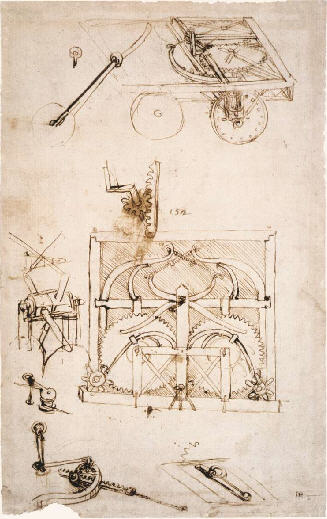
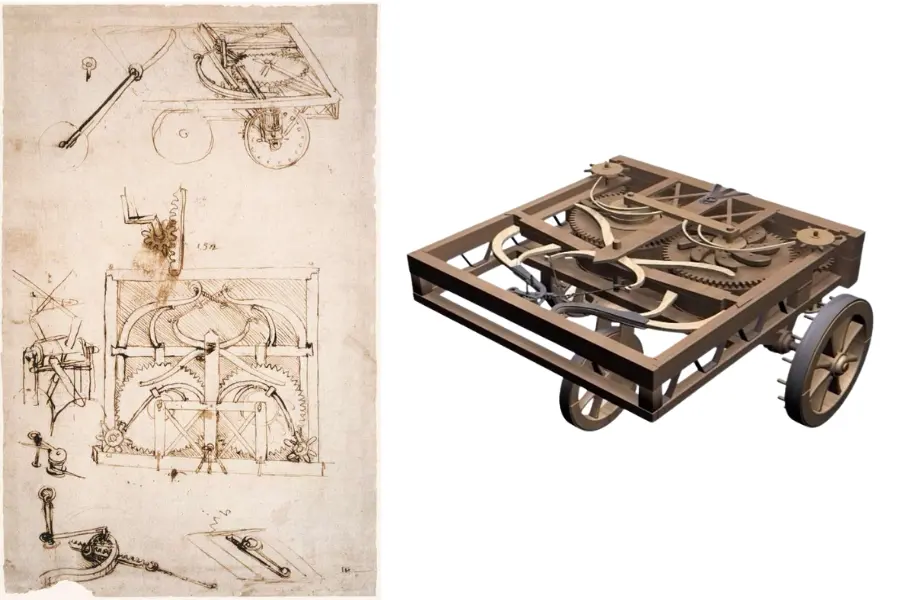
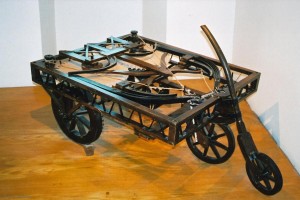
 I’m Leonardo Bianchi, the mind behind Leonardo da Vinci's Inventions. Thanks for visiting.
I’m Leonardo Bianchi, the mind behind Leonardo da Vinci's Inventions. Thanks for visiting. 